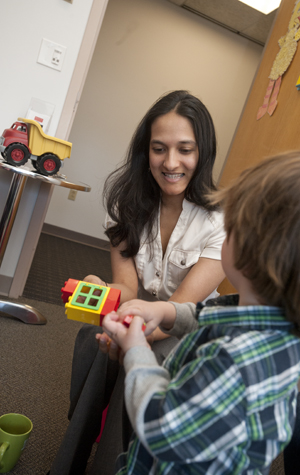To Moop or Not to Moop
SAR prof: toddlers comprehend verbs long before speaking them

“Learning language is really one of the great mysteries of human cognition,” says SAR’s Sudha Arunachalam. Photos by Vernon Doucette
They don’t talk much, but they listen. And learn. Even the youngest toddlers are rapidly building a vocabulary, even if they aren’t able to reproduce aloud all they’ve learned. In fact, when a child hears an unfamiliar verb, even absent a visual cue, she will usually figure out from the context of the sentence whether it’s transitive or intransitive, then file it away and retrieve it when she encounters a likely definition. (She sees her brother rubbing Fido, then remembers that Mommy spoke of petting the dog.)
That’s the finding of Sudha Arunachalam, director of the BU Child Language Lab and a Sargent College assistant professor of speech, language, and hearing sciences, which was published in a 2012 issue of the journal Language and Cognitive Processes.
“Learning language is really one of the great mysteries of human cognition,” says Arunachalam. “Children understand more than they say.”
In the past, the language scientist explains, studies of lexical acquisition focused on nouns, because generally the first words out of a child’s mouth are indeed nouns. Parents naturally think teaching words means, “I hold up a ball and say, ‘Look, here’s a ball. Do you see the ball?’” she says. “But real-world learning is much more complicated than that, and verbs in particular are more complicated, which is why we chose to look at them.”
Arunachalam and colleagues established in a 2010 study that 27-month-olds are capable of correctly identifying a verb’s syntactic properties. They showed children a video of a conversation with a made-up verb cast as either transitive (“The boy wants to moop the ball”) or intransitive (“The boy and the dog want to moop”). Then the toddlers watched two scenes side by side: one depicted a boy spinning a girl in circles, the other, the boy and girl each waving one hand. Finally, the children were asked to point to the scene that showed mooping. Those who’d started with the dialogue video where moop was transitive picked the transitive video (the boy acting upon the girl by spinning her), and those who’d watched the intransitive dialogue picked the intransitive scene (the boy and girl together performing an action, waving, with no object).
In her latest study, Arunachalam tried the same experiment, but with even younger children—most 21 months, some just 19 months—and with a technological twist: instead of asking the toddlers to indicate their choice by pointing, she used a corneal reflection monitor to track their eye movements upon hearing the question. “It’s kind of extraordinary,” she says. “We can measure their comprehension by almost literally looking through their eyes.”

Despite the challenges of working with such young subjects (the journal article notes that “nine toddlers were excluded from analysis due to fussiness”), Arunachalam and colleagues again found that most of the children got the transitive-intransitive distinction. “Clearly, then, 21-month-olds have what it takes to benefit from cross-situational learning,” she wrote, meaning that “they can glean whatever information is available about a novel verb in one encounter, and access that information in a subsequent encounter.”
That held true for the study’s few 19-month-olds, she adds. “Most 19-month-olds are barely putting words together in a sentence—and they aren’t producing transitive or intransitive structures. But our study made clear that not only can they learn new verbs, they can learn them just from hearing this kind of syntactic information.”
It’s a remarkable advance in our understanding of how children learn words, and Arunachalam isn’t finished by a long shot. She’s planning to study the effect a good nap has on word learning. “Sleep has been shown to have a large role in memory consolidation,” she says, “but there’s been very little work on memory for language, and no work on memory for word meanings in children.”
Currently, she is running the eye-tracking test again, but this time “extracting the social context from the situation to make it even harder,” she says: rather than a video of a conversation, children are shown a dull video of shapes moving while they hear the novel verb spoken within a stream of unrelated sentences. It’s too early to draw a conclusion, she says, but so far, “the trend is in the right direction. They do seem to be learning.”
This study may have implications for the teaching of language to children suffering from autism. “Perhaps this would be helpful for them,” Arunachalam says. “Maybe they would learn more easily in a context in which they didn’t have to sit next to somebody or look at somebody or be explicitly taught something, but rather they could pick up information more from ambient noise.” At the least, she says, this exercise could provide the children a foundation for later learning.
The biggest challenge for the language lab is simply getting participants. “We need 80 kids per study—80 kids whose data we can use,” Arunachalam says. “Occasionally a kid will walk in the room and just want to leave. Or he’ll keep holding a cup of Cheerios in front of his face, and we cannot get him to put that cup of Cheerios down.” Nevertheless, she adds, “We’ve had tremendous success.”
For parents of toddlers, Arunachalam offers this takeaway: “Children are listening and learning, even when they are just overhearing speech that isn’t directed specifically to them. So keep the household conversation going.”
A version of this article was originally published in the fall 2012 issue of Inside Sargent.
Comments & Discussion
Boston University moderates comments to facilitate an informed, substantive, civil conversation. Abusive, profane, self-promotional, misleading, incoherent or off-topic comments will be rejected. Moderators are staffed during regular business hours (EST) and can only accept comments written in English. Statistics or facts must include a citation or a link to the citation.